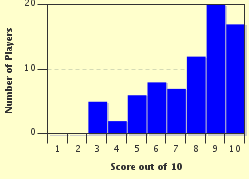Quiz Answer Key and Fun Facts
1. "Alas, Poor Yorick, I knew him, Horatio!" Hamlet fondly remembers the jester he knew as a child. In 1603 a version of the play "Hamlet" appeared in the First Quarto of Shakespeare's works, and that same year, Shakespeare's Lord Chamberlain's Men were renamed the King's Men. Do you know the new ruler of England who inspired the name change?
2. "The funeral baked meats did coldly furnish forth the marriage tables," Hamlet bitterly observes of the short time between his father's death and his mother's remarriage. Shakespeare's "Hamlet" was performed in 1607 aboard a merchant ship commissioned by a capitalist enterprise remembered for transporting spices from the East to make food last longer and taste better. Do you remember what company was chartered by Queen Elizabeth I in 1600 to engage in exploration and trade?
3. Shakespeare's "Hamlet" is filled with portents of war, and in the opening scene, Horatio remembers Hamlet's father in his armor and describes the ghost he has seen as having "that fair and warlike form in which the majesty of buried Denmark did sometimes march" when at war with Norway. What war would break out in 1618, involving a united Denmark-Norway and many other European countries in conflict for the next three decades?
4. The ghost of Hamlet's father remembers his situation in the afterlife and tells his son, "I could a tale unfold whose lightest word would harrow up thy soul, freeze thy young blood"; Hamlet says he "could drink hot blood" in his passion for revenge; and a form of the word "blood" occurs almost thirty times in the play. In 1628, physician William Harvey wrote a book demonstrating his shocking notion that blood circulates through the body, pumped by the heart. Up to that time, what organ was thought to be the source of blood?
5. Near the end of Shakespeare's "Hamlet" the prince baits the foolish courtier Osric into changing his mind about whether it is hot or cold and confuses Osric by asking him to "remember" his hat; however, there was no mistaking the weather later in the 17th Century. What weather-related event happened in London in 1683-84?
6. When Shakespeare has his character Hamlet say "I could be bounded in a nutshell and count myself a king of infinite space" he may be remembering rumors of Italian astronomer and scientific experimenter Galileo Galilei, born the same year as Shakespeare himself. When Galileo related his observations of stars, planets, and moons in "The Starry Messenger" ("Siderius nuncius") in 1610 and followed it up with other books in later years, what body investigated his ideas as heresy?
7. There's a plot twist in Shakespeare's "Hamlet" when "sea-faring men" arrive at the Danish royal court with a letter from the prince describing how, on a ship bound for England where the king had meant him to be killed, he was the only person captured by pirates, who treated him like "thieves of mercy" (good guys). Do you recall the name of a pirate turned explorer who sailed around the world three times during the 17th and early 18th centuries, described Western Australia's shores and people seventy years before Captain Cook sailed to the continent, wrote best-selling books about his travels, and was recognized by the Royal Society for his contributions to knowledge of the natural world?
8. "This above all: to thine own self be true," Polonius in Shakespeare's "Hamlet" reminds his son Laertes, who is heading back to college in France. Education in 17th Century Europe was religious, and France was a Roman Catholic country, although some towns were allowed Protestant schools in Shakespeare's generation, before such rights were withdrawn in 1629. What were French Protestants called?
9. "Frailty, thy name is woman!" Hamlet rails at his mother Gertrude the queen of Denmark (twice over) for failing to remember his father's virtues; however, many women of the 17th Century were made of strong stuff. In 1603, King James I followed one of the most dynamic rulers in history, Queen Elizabeth I. James's royal consort was Anne, also a strong-minded woman; where would Hamlet have been happy to know Anne was born?
10. "Remember, remember the fifth of November!" is not from Shakespeare, but Hamlet goes to university at Wittenberg, where Martin Luther famously nailed 95 Theses on a church door in 1517, so the Danish prince (if he lived in the time the play was written) would get a Protestant education. The 1605 Gunpowder Plot did not succeed in killing King James I for the Roman Catholic cause, but his son was killed by militants on the other side of a political and religious war in 1649. During what internecine conflict was Charles I executed?
Source: Author
nannywoo
This quiz was reviewed by FunTrivia editor
gtho4 before going online.
Any errors found in FunTrivia content are routinely corrected through our feedback system.

